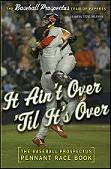One of the biggest discussions in sabermetric circles over the last 3 years has been Voros McCracken's Defense Independent Pitching Stats (DIPS). I was reminded of this recently while reading a discussion on baseballprimer.com. Essentially, DIPS suggests that major league pitchers shouldn't be evaluated based on the number of hits allowed since they don't control what percentage of balls put in play turn into hits. This idea has significant consequences and boils down to evaluating pitchers based on how few balls they allow to be put in play. In fact, McCracken found that ERA was better correlated with strikeout and walk rate and ability to prevent homeruns than with hits given up. McCraken's work was so revolutionary that it was noticed by some big league teams and I believe he now consults for the A's.
DIPS seems counterintuitive since a baseball fan knows that certain pitchers seem to be able to induce more ground balls or weak swings by batters which are more easily translated into outs via popups or shallow flyballs. Related to DIPS what I found interesting on baseballprimer.com were the following stats (where BIP is balls in play):
2003 % BIP Outs % BIP
Ground Balls 73.6% 48%
Fly Balls 87.2% 33%
Line Drives 27.2% 19%
So, just looking at these numbers it's clear that since the odds of a ball put in play being made into an out are so much higher for ground balls and fly balls than for line drives, that a pitcher who could minimize line drives would be saving themselves a few hits per year. In addition, a fly ball pitcher who does not give up a lot of homeruns would doubly benefit since they don't give up runs in bunches while taking advantage of the higher out% on fly balls. However, since only about 13.8% of balls put in play are line drive hits (.19 * (1-.272)) the ability to get sure outs (strikeouts), avoid putting men on base for free (walks), and staying out of multiple run situations (hr/ip) would naturally correlate more strongly with ERA. The lower percentage also means that there will be more variability in the percentage of line drives turned into outs even for good pitchers and so once again the other measures will more consistently predict a pitcher's performance. If you couple this with the fact that line drives as a percentage of balls put in play for major league pitchers varies between 18% and 23% (in other words, its not like Greg Maddux gives up only 5% of BIP as line drives while Shawn Estes gives up 30%), then you can see why these other rate stats seem to outweigh any ability to induce batters to hit fewer line drives and hence why DIPS has gained respect in the sabermetric community.
All of this however, does not answer the central question of whether a pitcher has the ability or skill to induce fewer line drives per balls put into play regardless of the magnitude of that effect on their ERA. I found a great article on this topic from Diamond Mind which for me seems to answer the question fairly definitively. As you might have guessed certain pitchers such as knuckleballers (Charlie Hough, Tim Wakefield, and Phil Niekro are all in the top ten) have the best ability to do this and that bad pitchers give up a higher percentage of hits per ball put into play because they give up more line drives. In other words, DIPS is a good predictor of success because of the greater percentage of flyballs and groundballs both put into play and turned into outs, but pitchers do have the ability to prevent line drives thereby saving themsevles hits.
This also points out that major league pitchers can be very successful pursuing one of several different strategies.
1. Strikeout alot of batters in order to minimize the number of balls put into play and therefore balls that will be hits (Nolan Ryan)
2. Walk very few batters and give up very few homeruns to minimize the effect of the hits you do give up (Greg Maddux)
3. Walk fewer batters than average but strikeout more than average to minimize base runners and balls hit into play (Fergie Jenkins)
4. Rely on deception to decrease the number of hard hit balls thereby decreasing the pct of balls put into play that turn into hits (Charlie Hough)
5. Walk very few batters but rely on keeping hitters off balance to minimize base runners and minimize the number of line drives (Jamie Moyer)
Clearly, if you're not a big strikeout pitcher, have great control, a trick pitch, or a deceptive repetoire, which is most pitchers, then DIPS is a good way to predict your success by suggesting a 6th strategy - maintain above average strikeout and walk rates while giving up fewer than the average rate of hr/ip.
125x125_10off+copy.jpg)



No comments:
Post a Comment